


SITE LOGIN
-
REVIEWS
- Ski Gear
- Clothing
- Accessories
- Off-Season Gear
- Lifestyle
- Lodges and Accommodation
- Nutrition
- Manufacturers
- Destinations
- Training
- Gear of the Year
- Best New Summer Gear
-
Holiday Gift Guide
-
Holiday Gift Guide 2024
- Holiday Gift Guide 2024 Base Layers
- MSR Explore Revo Snowshoes
- Fieldsheer Backcountry Heated Jacket
- Fieldsheer Premium 2.0 Merino Heated Socks
- MEC Hut Booties and Slippers
- Arc’teryx Kopec GTX Shoe
- Arc’teryx Kragg Insulated Approach Shoes
- Gregory Verte 18 Backpack
- Grundens Deck-Boss Ankle Boot
- MEC Northern Light Vest
- Montec-Scope-Ski-Goggles
- Mountain Hardware Kor Airshell Hoody
- Mountain Hardware Kor Alloy Crew
- Arcade Atlas Belt
- Dynafit Ridge Dynastretch Jacket
- Shokz OpenRun Pro 2 headphones
- Buff Merino Move Multifunctional Neckwear
- Bootdoc Foot Warmer
- Cotopaxi Allpa 42L Travel Pack
- DPS LastBag
- DPS PHANTOM Glide At-Home Kit
- DPS Mission Quiver Roller
- Dragon Amped sunglasses
- Dragon DX3 Plus OTG photochromic goggle
- Fuse Lenses Anclote Flashback
- Garmin Fenix 8 Solar Sapphire Watch
- Gregory Alpaca Gear Tote 30
- Hotronic Boot Dryer
- MEC Aluminum Pot Set
- Gnara Go There Pants
- Grundens Shackleton 2.0 Duffel
- Jones Deeper 19L Backpack
- Le Bent Core Midweight Crew base layer
- Leatherman ARC
- Montane Nordes Hooded Softshell Jacket and Pants
- Helly Hansen Odin Everdown Hooded Jacket
- Helly Hansen Verglas Infinity Shell Jacket 2.0
- Montec Fawk Ski Jacket
- Pomoca Free Pro 2.0 Skins
- Rab Glaceon Pro Down Jacket
- Rab Khroma Converge GORE-TEX Ski Jacket & Pants
- Smith Squad MAG Goggles
- Stellar Guide Aerogel Hybrid Hood 2.0
- Stellar Ultralight Down Hood 2.0
- Arms of Andes Alpaca Half Zip & Wool Leggings
- Cotopaxi Allpa 70L Duffel Bag
- Giro Taggert Mips Helmet
- Loonr Hi Flyer Boots
- Paka Mountain Crew
- Roll Recovery SUPERPLUSH Classic Shoes
- Smartwool Smartloft Hooded Jacket and Pants
- Ortovox Switchback 32 Ski Touring Backpack
- Cotopaxi Allpa X 3L Hip Pack
- Giro Sagen Ski Goggle
- Icebreaker Ski+ Over the Calf Socks
- MEC-Fireside-Fleece-Snap-Pullover
- Montec Roast Mittens
- Mountain-Hardware-Sunblocker-Hoody
- MSR Titan Kettle 900 ml
- Tailgate-Industries-The Gondom-Goggle-Cover
- Wild Country Rope Tarp
- Bootdoc Race Merino PFI 50 Socks
- Remind Soles Destin Impact Insoles
- Kari Traa Rose Baselayer Half Zip Top and Pants
- Le Bent Midweight Quarter Zip
- Ombraz Dolomite Sunglasses
- Ortovox Fleece Rib Hoody
- Ortovox Merino Thermovent Base Layer
- Smartwool Intraknit Merino Tech Half Zip
- Suunto Wing Bone Conduction headphones
- Sweet Protection Adapter Mips Helmet
- Sweet Protection Connor Rig Reflect Goggles
- Zeal Optics Selkirk Glacier Glasses
- Norrona more flex1 Pants
- Norrona Octa Zip Hood
- Norrona Lyngen Alpha100 Zip Hood
- MEC Deluxe Pillow
- Holiday Gift Guide 2023
- Holiday Gift Guide 2022
- Holiday Gift Guide 2021
- Holiday Gift Guide 2020
- Holiday Gift Guide 2019
- Holiday Gift Guide 2018
- Holiday Gift Guide 2017
- Holiday Gift Guide 2016
-
Holiday Gift Guide 2024
- Pro Skier Interviews
- NEWS
- STORE
- ROUTES
- LODGING
-
VIDEOS
- 2022/23 Gear Reviews
- 2021/22 Gear Reviews
- 2020/21 Gear Reviews
- 2019/20 Gear Reviews
- 2018/19 Gear Reviews
- 2017/18 Gear Reviews
- 2016/17 Gear Reviews
- 2015/16 Gear Reviews
- 2014/15 Gear Reviews
- 2013/14 Gear Reviews
- 2012/13 Gear Reviews
- 2011/12 Gear Reviews
- 2020 Outdoor Retailer
- 2019 Outdoor Retailer
- 2018 Outdoor Retailer
- 2017 Outdoor Presscamp
- 2017 Outdoor Retailer
- 2016 Outdoor Presscamp
- 2016 Outdoor Retailer
- 2015 SIA Show
- 2014 Outdoor Retailer
- 2013 SIA Show
- 2012 Outdoor Retailer
- Tips and Tricks
- Backcountry Skiing
- SAFETY
- ABOUT
- REVIEWS
- NEWS
- STORE
- ROUTES
- LODGING
-
VIDEOS
- 2022/23 Gear Reviews
- 2021/22 Gear Reviews
- 2020/21 Gear Reviews
- 2019/20 Gear Reviews
- 2018/19 Gear Reviews
- 2017/18 Gear Reviews
- 2016/17 Gear Reviews
- 2015/16 Gear Reviews
- 2014/15 Gear Reviews
- 2013/14 Gear Reviews
- 2012/13 Gear Reviews
- 2011/12 Gear Reviews
- 2020 Outdoor Retailer
- 2019 Outdoor Retailer
- 2018 Outdoor Retailer
- 2017 Outdoor Presscamp
- 2017 Outdoor Retailer
- 2016 Outdoor Presscamp
- 2016 Outdoor Retailer
- 2015 SIA Show
- 2014 Outdoor Retailer
- 2013 SIA Show
- 2012 Outdoor Retailer
- Tips and Tricks
- Backcountry Skiing
- SAFETY
- ABOUT
TOP VIDEOS
Salomon Q-105 Skis
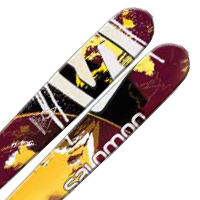 Salomon's new Quest line of products includes the Q-105 skis which will hit the ski shops in the fall of 2013 along with new Quest boots, Quest Packs and Quest Motion Fit jacket and Pants. Salomon has been one busy company, and so have we. We here at Backcountry Skiing Canada have been skiing on the Salomon Q-105 and Q-98 skis since mid February and we've been rockin' them along with the new Salomon Motion Quest pants and jacket and the Salomon Quest Max 120 BC Boots. If you haven't already read our review of the Salomon Q-98 skis give that a read first as it explains much of the similarities and differences between the Rocker 2 line up of skis and those in the new Quest line. In this review I am going to focus mainly on how the Q-105 skis differ from that of the Q-98s. The most obvious difference is the fact that the Q-105s are 7mm narrower at the waste than the Q-98, hence the name. There you have it, review done.
Salomon's new Quest line of products includes the Q-105 skis which will hit the ski shops in the fall of 2013 along with new Quest boots, Quest Packs and Quest Motion Fit jacket and Pants. Salomon has been one busy company, and so have we. We here at Backcountry Skiing Canada have been skiing on the Salomon Q-105 and Q-98 skis since mid February and we've been rockin' them along with the new Salomon Motion Quest pants and jacket and the Salomon Quest Max 120 BC Boots. If you haven't already read our review of the Salomon Q-98 skis give that a read first as it explains much of the similarities and differences between the Rocker 2 line up of skis and those in the new Quest line. In this review I am going to focus mainly on how the Q-105 skis differ from that of the Q-98s. The most obvious difference is the fact that the Q-105s are 7mm narrower at the waste than the Q-98, hence the name. There you have it, review done.
Ok, maybe there is actually more to it that that. True, the Q-105s and Q-98s are very similar but at the same time that 7mm makes a world of difference, for the better in powder. On top of that, the width underfoot is not the only difference. The Q-105 skis are also 1mm narrow at the tip, 5mm fatter at the tail and have a larger turn radius by almost 3 meters. They tip the scales with an additional 276 grams and will set you back an extra 120 bones. You would not be too far off the mark if you were to assume that the Q-105 is just a fatter version of the Q-98. The performance, however, is quite a bit different.
Salomon poster boy Cody Townsend explained it well by saying “Twin rockered skis like Rocker2 are amazing in powder, but in mixed snow you really have to be on ‘em. Q-Line is more forgiving if you get tired, or lean back, or find yourself in variable snow or hardpack. They’re awesome for intermediate skiers as well" Both the Salomon Q-98 and Q-105 are solid skis that perform well at the resort as well as being able to go out past the ropes when the conditions permit. They are able to ski it all, chop, pow, crud and groomers. So how do they do this, well if you missed the Salomon Q-98 review here are the details on the main features of the Salomon Q-105s. As you may have guessed, the features are the same as those in the Q-98 so rather than try and say the same thing with new words here is the copy and past version.
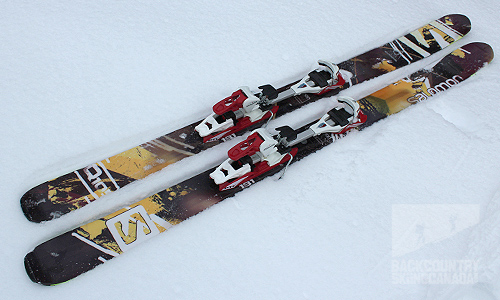
Utility Rocker:
What Salomon calls their "Utility Rocker" is the combination of an early rise tip, camber under foot and a subtle tail rise. The tip rise is fairly generous and keeps the tip floating in powder and chop while the traditional camber underfoot allows the ski to carve on groomers and hard pack. The tail rise is minimal so it finishes the turn nicely and provides more control than a twin-rocker ski. This more traditional shape provides a solid platform with the early rise giving you the flotation you need for powder days in the backcountry.
Camber under foot + early rise = Utility Rocker
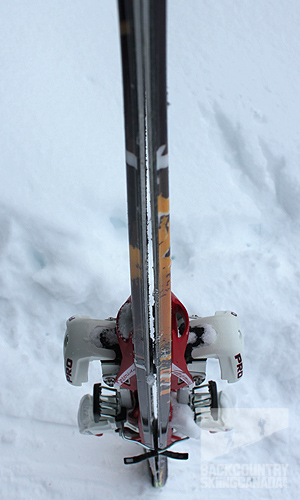
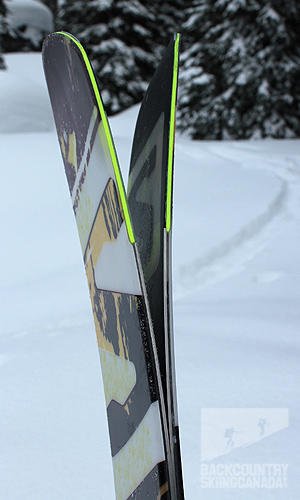
5 point side cut:
Salomon's 5 point sidecut is used not only on the entire Q line of skis but also the Rocker 2 line up. It is so named for the 5 points along the ski’s shape: narrow at the tip, wide towards the middle, narrow under foot, wide again towards the back and then finally narrow at the tail. Count them all up and you get the five points. The real magic with the 5 point side cut happens because the widest point of the ski is pulled back from the tip and tail more than other skis of similar shape. This design eliminates any chance of "hooking" the ski in chop and on groomers, which we have experienced with other skis of similar design.
Honeycomb & ABS tip and tails:
Anytime you have an early rise tip or tail you inevitably get ski chatter. It only makes sense, take the ski extremities off the snow and vibrations take over and you get chatter. Chatter reduces control and vibrations can be amplified. To reduce vibrations and chatter, Salomon uses a honeycomb structure (called Koroyd) and ABS in the tip and tail of the ski. This design also reduces the weight and, therefore the inertia to swing which makes the Salomon Q-98s more maneuverable and gives the skier more control than skis without these technologies. The Solomon Koroyd structure is touted as being superior to traditional honeycomb structures as rather than being glued together, the Koroyd cores (think thousands of small extruded tubes or cylinders) are thermally welded. This eliminates weak points found in traditional hexagon core structures. Koroyd is very light weight and provides dampening to the tip and tail of the Q-98 skis which you will notice on groomers and hard pack snow conditions.
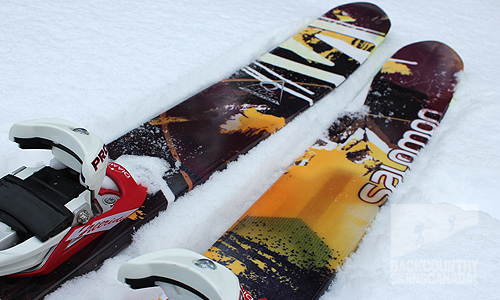
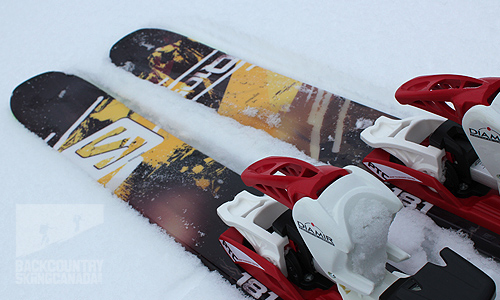
The Q-line up of skis is available in many widths from the Q-90, Q-98, Q-105 all the way up to the Q-115. For the ladies there's the Salomon Q-88 Lux, Salomon Q-96 Lumen and Salomon Q-106 Stella.
Transparent top sheet is pretty cool.
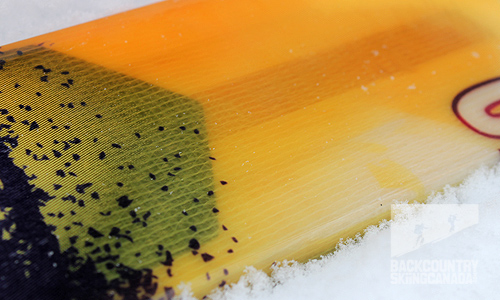
Cap construction for torsional rigidity.
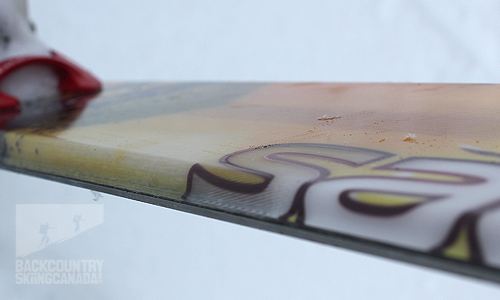
Tips from the front and the back.

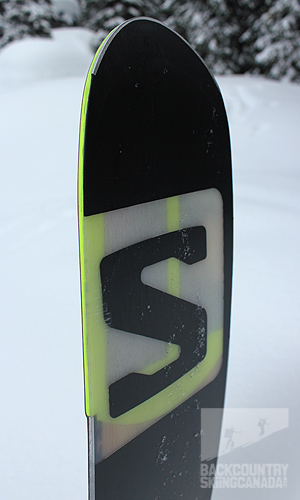
Fritschi Diamir Freeride Pro Binding:
We mounted the Salomon Q-98 skis with the Fritschi Diamir Freeride Pro bindings which have a DIN range of 4-12 and weigh in at 2.2kg or 4lb 8oz. With four height adjustments at 0°, 3°, 9° or 13° they provide lots of choice while climbing. The new wider base plates allow for better transmission of power more evenly across todays fatter skis. The Freeride incorporates 'Gliding Technology' which places the pivot point on the toe piece behind the toe of your boot and combined with the moving baseplate allows you to raise your foot until it is completely perpendicular to the ski which results in a more natural stride when skinning. The price point for the Fritschi Diamir Freeride Pro binding is $499.95 US. If you are looking for a durable all-around-resort/ski-touring binding then consider the Salomon Guardian 16 AT binding which we have reivewed over here.
Verdict:
It's not often that I can find that true one quiver ski, but when I do my smile is from ear to ear. The Q-105s are that unique ski that will keep a smile on your face no matter the terrain or conditions. Way to go Salomon.
I have said it before but I will say it again the Salomon Q-line of skis are super fun, they're snappy on the groomers without any tip chatter, holding an edge is pretty much effortless and they can go from edge to edge all day long. There is just enough camber to make turn initiation easy and the more or less flat tail finishes the turn nicely. In powder the Q-105 offers a much better platform for deeper snow thanks to the "Edgy Monocoque" as Salomon calls it which is a cap construction design and full wood core. You'll also be amazed at what those 7 little millimetres underfoot do for your backcountry enjoyment.
This ski feels incredibly solid but doesn't tip the scales too heavily so it is still acceptable on the up track. The utility rocker we mentioned above provides a pressure zone of 56% when the ski is flat and 85% when the ski is on edge. This provides fast easy turns while the 5 point taper ensures no hooking or grabbing of the ski. The honeycomb & ABS lightens up the ski’s extremities and gives you better float with less swing weight so you don't have to drive the turns as hard as with other skis. This all adds up to one fun ski for resort or backcountry. So what could be improved upon? Well, not much. If the weight could be brought down a little without sacrificing that solid feel then this ski would be even better in the backcountry for longer tours and multi day traverses. Other than that this is a solid ski that you should definitely check out.
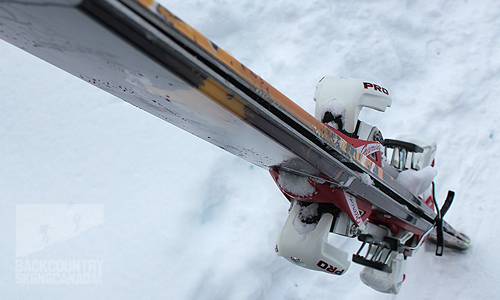
SPECS:
Price: $749 CAN
Lengths (cm): 167/174/181/188
Dimensions: 133/104/125 (180cm length)
Radius: 23.3 (180cm length)
Weight: 2022g / 4.85lb (180cm length, per ski)
PROS:
- A fat ski that can also carve the groomers and transition from edge to edge quickly.
- No chatter and the early rise tip to floats in the pow.
- 5 lengths to choose from.
- A solid durable ski that is at home in deep or variable snow
CONS:
- Not a fan of the top sheet design but I do like the subtle translucent art that shows off the core.
- Lighter would be better for dedicated backcountry skiing.
Rating: 9/10
Powder Performance 2/2
Groomer Performance 1.5/2
Stability 2/2
Weight 1.5/2
Value 2/2
This is only our opinion. Do you disagree? Did we miss something? Are we totally out to lunch? Join the discussion in the forums here, and let us know what you think. People like/dislike gear for different reasons so chime in and we'll get a well-rounded evaluation.
Back to the rest of the reviews.
Copyright © 2023-24 Backcountry Skiing Canada. All Rights Reserved.







